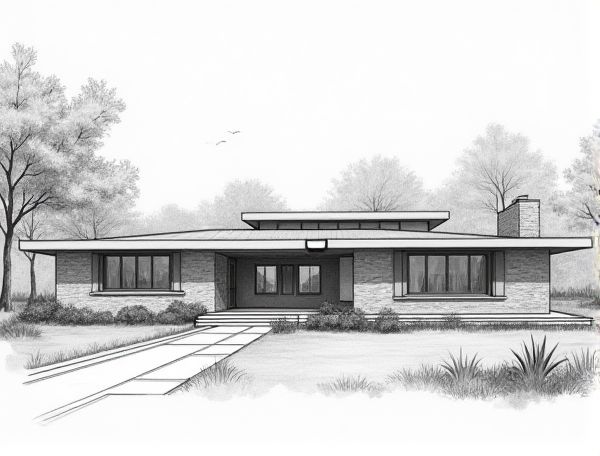
Photo illustration: Prairie School home design with ribbon windows
Prairie School home design emphasizes horizontal lines and integration with the landscape, featuring ribbon windows that create continuous bands of glass to enhance natural light and panoramic views. Discover how these distinctive window designs can transform your living space by reading more in the article.
Introduction to Prairie School Home Design
Prairie School home design emphasizes horizontal lines, flat or hipped roofs with broad eaves, and integration with the surrounding landscape, reflecting the natural beauty of the Midwest. You can create a harmonious living space by incorporating open floor plans, natural materials, and handcrafted details that characterize this iconic American architectural style.
Key Characteristics of Prairie School Architecture
Prairie School architecture is characterized by its horizontal lines, flat or hipped roofs with broad overhanging eaves, and integration with the landscape, promoting harmony between the structure and its natural surroundings. Your home design can benefit from open floor plans, rows of windows for natural light, and handcrafted details that emphasize simplicity and craftsmanship.
The Origins and Influences of Prairie Style
Prairie Style architecture originated in the early 20th century, primarily influenced by Frank Lloyd Wright's vision of harmony with the natural landscape, emphasizing horizontal lines and open interior spaces. This design movement was inspired by the expansive, flat plains of the American Midwest and integrated elements of Japanese architecture, Craftsman aesthetics, and Arts and Crafts principles to create a uniquely American architectural identity.
Signature Elements: Horizontal Emphasis in Prairie Homes
Signature elements of horizontal emphasis in Prairie homes include low-pitched roofs, extended eaves, and continuous bands of windows that create a strong visual connection with the surrounding landscape. Your home design can incorporate these features to achieve a harmonious balance between structure and nature, emphasizing spaciousness and organic flow.
The Role of Ribbon Windows in Prairie School Design
Ribbon windows in Prairie School design emphasize horizontal lines that blend the structure with the natural landscape, enhancing your home's openness and flow. These continuous bands of windows maximize natural light, fostering a sense of spaciousness and connection to the outdoors. Incorporating ribbon windows supports key architectural principles of Frank Lloyd Wright's Prairie style, balancing aesthetic appeal with functional benefits.
Materials and Color Palettes Used in Prairie Homes
Prairie homes prominently feature natural materials such as wood, stone, and brick, emphasizing organic textures and earthy tones that blend seamlessly with the surrounding landscape. The color palettes typically include warm browns, muted greens, soft tans, and deep rusts, reflecting the natural environment and enhancing the home's harmonious integration with nature. These materials and colors collectively create a grounded, inviting atmosphere that highlights craftsmanship and architectural lines characteristic of Prairie-style design.
Notable Architects Behind Prairie School Movement
Notable architects behind the Prairie School movement, including Frank Lloyd Wright, Walter Burley Griffin, and Marion Mahony Griffin, revolutionized home designing by emphasizing horizontal lines, flat or hipped roofs, and open interior spaces. Their innovative use of natural materials and integration with the surrounding landscape created harmonious living environments that continue to inspire contemporary architecture. Understanding these architects' principles can help you shape a unique and timeless home design reflecting organic aesthetics and functionality.
Advantages of Ribbon Windows for Modern Living
Ribbon windows enhance modern living by maximizing natural light and providing uninterrupted panoramic views, boosting energy efficiency through better ventilation and heat regulation. Their sleek horizontal design complements contemporary architecture, creating a seamless connection between indoor and outdoor spaces. You benefit from improved aesthetics and increased home value, making ribbon windows a smart investment for stylish functionality.
Interior Layouts and Floor Plan Features
Maximizing your home's interior layout and floor plan features enhances spatial flow and functionality, ensuring each room serves its purpose efficiently. Incorporate open-concept designs, strategic storage solutions, and natural lighting to create a comfortable and aesthetically pleasing living environment.
Incorporating Prairie School Principles in Contemporary Homes
Incorporating Prairie School principles in contemporary homes emphasizes horizontal lines, open floor plans, and seamless integration with nature, creating a harmonious living environment. Use of natural materials like wood and stone enhances organic aesthetics while built-in furniture maximizes functional space. Expansive windows and low-pitched roofs allow abundant natural light and emphasize connection to the landscape, reflecting Frank Lloyd Wright's architectural legacy.
 homedesy.com
homedesy.com